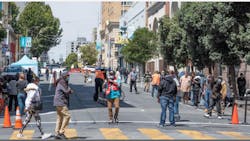SFMTA debuts safety measures in the Tenderloin
New traffic safety measures have been implemented for the Tenderloin Neighborhood by the San Francisco Municipal Transportation Agency (SFMTA), which include reducing the speed limit to 20 mph and prohibiting turns on red to help create safer streets for people who live, work and visit the area.
The changes are part of the city’s Vision Zero initiative, aimed at eliminating traffic fatalities and severe injuries through comprehensive, community-based approaches.
“Lowering speeds, expanding sidewalks and opening streets up to pedestrians are critical for the safety of people living in the Tenderloin. This neighborhood is home to the highest concentration of families, children and seniors in San Francisco, but at the same time, we also have the most dangerous transit corridors in the city,” said Supervisor Matt Haney. “The implementation of the 20-mph speed limit, along with various transit safety projects that are underway in the neighborhood, is going to significantly transform many of our high-injury streets and reduce preventable traffic incidents. This is a win for the residents who organized for these changes and made them happen, and this is a win for everyone in the neighborhood.”
San Francisco was among the first U.S. cities to adopt Vision Zero, an international movement to eliminate all traffic fatalities and severe injuries while increasing safe, healthy and equitable mobility for all. This effort puts San Francisco in the forefront of efforts statewide to reduce speed limits and enact other traffic safety measures, such as locally controlled speed camera pilot programs which are being introduced currently in state bills AB-43 (Friedman) and AB 550 (Chiu).
“Our focus on reducing speed limits in the Tenderloin District comes from a concerted effort involving residents and community non-profit groups dedicated to protecting our housed and unhoused residents,” said Jeffrey Tumlin, SFMTA director of transportation. “These measures are intended to create safe spaces for our vulnerable populations in a neighborhood where every single street is a part of the city’s high injury network.”
Severe and fatal crash incidence is ten times higher in the Tenderloin than in the rest of the city, according to San Francisco Police Department 2014-2019 data. In fact, every street in the Tenderloin is part of the city’s Vision Zero High Injury Network, which represents 13 percent of San Francisco streets yet accounts for 75 percent of the city’s severe traffic injury collisions and fatalities. In this high- density neighborhood, slowing speeds and eliminating turns on red lights will make streets and crosswalks safer.
“The transportation authority is proud to support this first-ever area-wide speed reduction project with transportation sales tax funds for the Tenderloin community,” said Transportation Authority Executive Director Tilly Chang. “We congratulate the SFMTA, WalkSF and the Tenderloin Traffic Safety Task Force, and look forward to continuing to improve safety and travel options in the neighborhood.”
The SFMTA has posted new speed limit signs on each block of the Tenderloin and placed electronic signage at key locations within the neighborhood. The agency is also running a multilingual digital ad campaign aimed at drivers in the Tenderloin and installing transit shelter posters and light pole banners in multiple languages to alert drivers, visitors and residents about the changes.
“These are exactly the kinds of changes that will save lives and slow our streets. These are especially needed in the Tenderloin, where so many families and seniors live,” said Jodie Medeiros, executive director for WalkSF. “Residents have been pushing hard for these improvements, and what a great win for safer streets.”
The Tenderloin is home to many of the city’s most vulnerable communities including historically marginalized groups such as people with disabilities, residents of supportive housing, people experiencing homelessness and limited-English proficient communities. The most recent Vision Zero effort builds on past comprehensive neighborhood-wide efforts in the Tenderloin, including daylighting and signal retiming, and a quick-build project to improve pedestrian safety on Taylor Street in 2019. Other changes to slow traffic and improve safety include upcoming bicycle and pedestrian safety quick-build projects on Golden Gate and Leavenworth Streets.
The speed limit reduction also builds on the Tenderloin Neighborhood Safety Assessment and Plan for COVID-19 aimed at increasing health and safety supports, focusing initially on a 13- block section. Efforts have encouraged safer streets and pedestrian/resident supports, such as block closures that have allowed the blocks to transform into vibrant community spaces with expanded sidewalk spaces and pedestrian walking spaces. A weekly closure of a Turk Street section provided temporary car-free space for children, seniors and Tenderloin neighbors, and the 100 block of Golden Gate has provided social services and food distribution on a closed street, daily.
